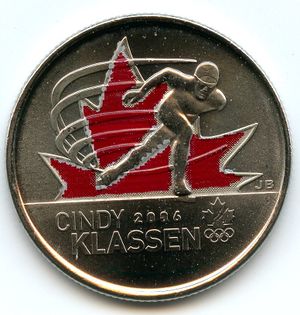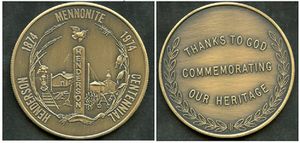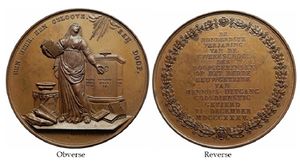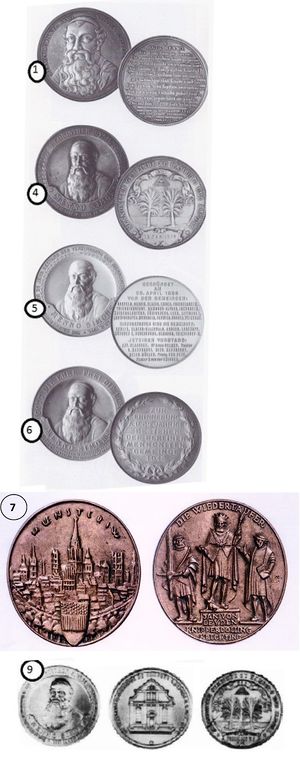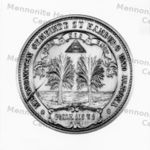Commemorative Medals
A commemorative medal, also called a medallion is issued by countries or organizations or individuals usually with a commemorative purpose and many are given as awards and thus form a permanent historical marker. They are often beautifully and artistically crafted coin like objects with a design on both sides to recognize national, sporting, military, academic or cultural achievements. Commemorative medals have been issued at least since Roman times. They can be displayed in small cases or worn like jewellery or suspended from clothing. Many collect these medals just because there is a pleasure in holding and examining an interesting intricately crafted metal object. Some can be valuable, and all have historic significance and can connect viewers to important events.
In 1534 when the Revolutionary Anabaptists controlled the city of Münster located in Nordrhein-Westfalen, Northwest Germany, they issued coin like objects of novel designs with no monetary designation but mimicking the standard one Thaler and half Thaler coins of that era. These coin medals were issued to promote their message and were to serve to propagate Anabaptist ideas and beliefs and to inform others of their success in Münster. After the capture of the city by its enemies a number of commemorative medals were issued to honour its capture including re-minting slightly modified original Anabaptist coins.
An example of a national commemorative medal is when Canada issued a commemorative 25 cent coin honouring Cindy Klassen who won five medals in the 2006 Winter Olympic Games. The coin was designed by Burlington, Ontario artist Jason Bouwman and issued in two forms, as a standard 25 cent piece and as a commemorative coin with the background maple leaf coloured red. The technical specifications of the coin are: 22 million pieces minted with 3 million of these minted as commemoratives, the metal used was stainless steel with a weight of 4.4 g and 23.88mm in diameter and 1.6 mm. in thickness. The standard image of Canada's Queen Elizabeth II is on the obverse of all the coins.

Photo: CMU Media Centre News Release.
Academic organizations like Mennonite universities and colleges often issue medals for academic or sporting achievements. (See an example from Canadian Mennonite University.)
Many organizations have issued commemorative medals to celebrate their important events and remember and commemorate anniversaries. (See example from Henderson, Nebraska.)
Some of the commemorative medals represent significant artistic skill by the engraver and the medals display important details and references to the event being commemorated; for example, the 1835 Medal commemorating the centenary of the Amsterdam Mennonite Seminary. This medal was produced in both bronze and silver. It is 44 mm in diameter and weighs 44.7 grams, its text is in Dutch with the date of 6 December 1835 in Roman letters on the reverse side. On the obverse side the engraver's name "D. van der Kellen" is given under the figure, and circling the top is the text “EEN HEER, EEN GELOOVE, EEN DOOP” which translates as "One Lord, One faith, One baptism." The standing veiled female figure representing Faith is centred, looking up to rays emanating from clouds, holding a Bible and extending her hand to other books on the ground before a pulpit which is inscribed with scriptural references “Matth XXVIII 18-20, Spruex: (Proverbs) XXIX 13 and Joh: III 5”; to her left is an inscribed baptismal font with volume titled BELIJDENIS (Confession) set on the pillow. The reverse side has a circling wreath of flowers and leaves and the text “DE HONDERDSTE VERJARING VAN DE KWEEKSCHOOL DER DOOPSGEZINDEN OP HET DERDE EEUWGETIJDE VAN MENNO'S UITGANG DODSDIENSTIG GEVIERD” which translates as “The hundredth anniversary of the Mennonite Seminary and the third century of Menno's exit religiously celebrated.”
Commemorative Medals (Dutch gedenkpenningen) are medals made of gold, silver, or other metal to commemorate certain historical events. There are a few memorial medals concerning Mennonite history:
- A medal in silver and also in pewter engraved in 1736 by Martinus Holtzhey, to celebrate Menno Simons' leaving the Roman Catholic Church in 1536. This medal shows on one side a portrait of Menno and on the other side a poem in the Dutch language.
- A medal in bronze, issued in 1845 to commemorate the 150th anniversary of the Mennonite conference in Friesland. This medal, engraved by T. A. Keikes, shows the conference represented as a woman with a cross on her breast. An old man on her right points at a ruin of an old church; at the left a young man and a new church; before her a cornucopia and a vase filled with coins. Legend: 1695 Friesche Doopsgezinde Sociëteit 1845. On the other side the inscription: ter gedagtenis aan III Julij MDCCCXLV.
- A medal, issued in 1898 for the congregation of Hamburg-Altona for presentation to members who celebrated their silver wedding. The medal contains on one side a portrait of Menno Simons; the other side was intended for an inscription.
- A medal commemorating the 350th anniversary of Menno Simons' death, engraved in 1909 by Johannes von Langa for the Hamburg-Altona congregation. This medal shows a portrait of Menno Simons and the symbols of the seal of the Hamburg-Altona congregation, that is, two palm trees divided by a body of water, and the all-seeing eye of God (exists in silver and bronze).
- A medal engraved by Johannes von Langa in 1911 on the occasion of the 25th anniversary of the Conference of German Mennonite congregations. One side shows the portrait of medal 4 (above) and laurel branches, other side an inscription with the names of the board of the Vereinigung der Mennoniten-Gemeinden im Deutschen Reich (exists in silver and in bronze).
- A medal commemorating the 25th anniversary of the Mennonite congregation of Berlin, Germany, engraved by Johannes von Langa in 1912. One side shows the portrait of Menno (as 4 above, but without laurel), the other side the inscription: Zur Erinnerung a. d. 25-jährige Bestehen der Berliner Mennoniten Gemeinde 1912 (silver and bronze). (For Nos. 1-6 see Doopsgezinde Bijdragen 1916, 75 f., 95-98.)
- A medal in bronze, engraved in 1935 by A. Mazotti, commemorating the fall of the Münsterite kingdom of Jan van Leyden, July 1535. The medal shows on one side the city of Münster according to an old picture, with the city coat of arms; the other side has portraits of Jan van Leyden, Knipperdolling, and Krechting.
- A medal was issued in 1835 to commemorate the centennial of the Amsterdam seminary and the tercentennial of Menno Simons' leaving the Catholic Church. The medal, engraved by van der Kellen, shows the muse of eloquence standing near a pulpit.
- Two bronze medals struck around 1976 from the 1898 dies of No. 3 (above) held in the Hamburg congregational archives -- one with the face of Menno Simons (50 mm diameter) and one with the facade of the former Mennonite Church in Altona, destroyed by bombs in 1943 (42 mm diameter). On the reverse side of both medallions is the seal of the Mennonite congregation of Hamburg and Altona.
As Mennonites became more accepted into Dutch society and gained some wealth beginning about 1647 they began to commemorate their silver or gold weddings anniversaries by issuing commemorative medals often in silver or gold. These medals are also important for Mennonite history.
Bibliography
Doopsgezinde Bijdragen (1916): 75f, 95-98.
Mennonite Brethren Herald (21 Jan 1977): 23.
Mevius Numisbooks International B.V. [commercial website]
Visser, Piet and Mary Sprunger. Menno Simons: places, portraits and progeny. Altona: Friesens, 1995: 102-103.
| Author(s) | Nanne van der Zijpp |
|---|---|
| Alf Redekopp | |
| Victor G. Wiebe | |
| Date Published | November 2019 |
Cite This Article
MLA style
Zijpp, Nanne van der, Alf Redekopp and Victor G. Wiebe. "Commemorative Medals." Global Anabaptist Mennonite Encyclopedia Online. November 2019. Web. 18 Apr 2024. https://gameo.org/index.php?title=Commemorative_Medals&oldid=168124.
APA style
Zijpp, Nanne van der, Alf Redekopp and Victor G. Wiebe. (November 2019). Commemorative Medals. Global Anabaptist Mennonite Encyclopedia Online. Retrieved 18 April 2024, from https://gameo.org/index.php?title=Commemorative_Medals&oldid=168124.
Adapted by permission of Herald Press, Harrisonburg, Virginia, from Mennonite Encyclopedia, Vol. 1, pp. 648-649; vol. 4, p. 1074. All rights reserved.
©1996-2024 by the Global Anabaptist Mennonite Encyclopedia Online. All rights reserved.
